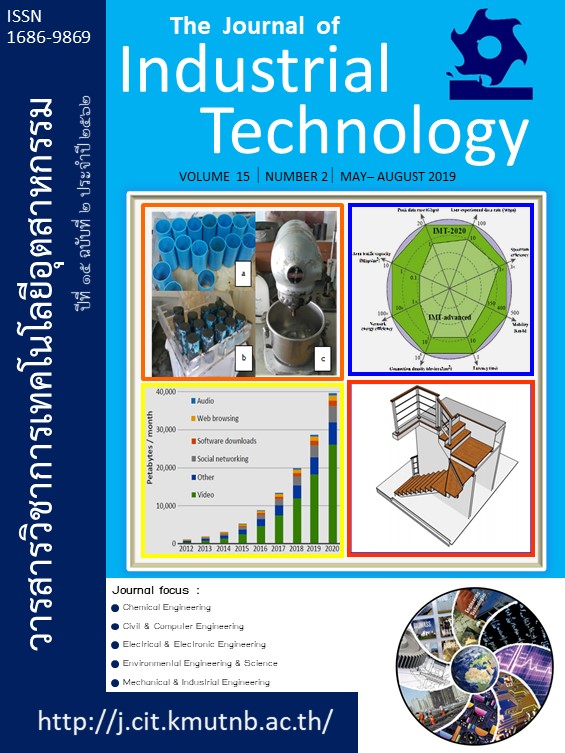การผลิตไฟฟ้าโดยใช้เซลล์เชื้อเพลิงจุลินทรีย์จากของเสียกลีเซอรอลและน้ำเสียโรงงานฟอกหนัง(Electricity Generation in Microbial Fuel Cells from Waste Glycerol and Tannery Wastewater )
Keywords:
Waste glycerol, Tannery wastewater, Microbial fuel cell technology, Electricity generationAbstract
Abstract
The aims of this research were compared the electricity generation and COD removal between waste glycerol and tannery wastewater with microbial fuel cell technology. The results showed power generation from waste glycerol and tannery waste water were obtained 0.0018 mW m-2 and 6.2 mW m-2, respectively. The COD removal efficiency can be obtained from waste glycerol and tannery wastewater 80 and 90%, respectively. The nitrogen removal efficiency from tannery wastewater in form of TKN (Total Kjeldahl Nitrogen) can be obtained 50%. Moreover, there are 2 parameters that indicated to oxidation-reduction reaction, which important reaction for microbial fuel cell are cyclic voltammetry (CV) and coulombic efficiency (CE). Cyclic voltammetry (CV) was showed the oxidation-reduction on electrode. Coulombic efficiency (CE) from waste glycerol and tannery wastewater were 7.62 and 15.6 %, respectively. There are parameters that showed the efficiency of electricity generation with 2 of substrates from microbial fuel cells. Therefore, microbial fuel cell technology that can be electricity generation from tannery wastewater better than waste glycerol.
References
[2] Pant D., Bogaert GV., Diels L., Vanbroekhoven K. A review of the substrates used in microbial fuel cells (MFCs) for sustainable energy production. Bioresource Technology., 2010, 101 (6), 1533-1543.
[3] Zhi W., Ge Z., and Zhanng H. Method for Understanding Microbial Community Structures and Functions in Microbial Fuel Cells: A Review. Bioresource Technology 171 (2014) 461–468.
[4] Du, Z., Li, H., & Gu, T. (2007). A state of the art review on microbial fuel cells: a promising technology for wastewater treatment and bioenergy. Biotechnology Advance, 25(5), 464-482. doi: 10.1016/j.biotechadv.2007.05.004.
[5] Liu WF., and Cheng Sa. Microbial fuel cells for energy production from wastewaters: the way toward practical application. Journal of Zhejiang University-SCIENCE A (Applied Physics & Engineering). 2014 15(11):841-861.
[6] Almeida, J. R M., Fávaro1, L. C. L., & Quirino, B. F. (2012). Biodiesel biorefinery: opportunities and challenges for microbial production of fuels and chemicals from glycerol waste. Biotechnology for Biofuels, 5, 48. https://doi.org/10.1186/1754-6834-5-48.
[7] Liu H., and Logan BE. Electricity Generation Using an Air-Cathode Single Chamber Microbial Fuel Cell in the Presence and Absence of a Proton Exchange Membrane. Environ. Sci. Technol., 2004, 38 (14), pp 4040–4046.
[8] American Public Health Association-American Water Works Association-Water Pollution Control Federation (APHA-AWWA-WPCF). (2000) Standard Methods for the Examination of Water and Wastewater, 20th ed. APHA, Washington, DC.
[9] Chontisa Sukkasem. Microbial Fuel Cell: Novel Technology “Convert Wastewater to Electricity”. KKU Engineering Journal Vol.38 No. 3 (347 -362) July – September 2011. (in Thai)
[10] Hou B., Hu YY., Sun J., and Cao YQ. Effect of Anodic Biofilm Growth on the Performance of the Microbial Fuel Cell (MFC). 2010 4th International Conference on Bioinformatics and Biomedical Engineering.
[11] Liu H., Cheng S., and Logan BE. Production of Electricity from Acetate or Butyrate Using a Single-Chamber Microbial Fuel Cell. Environ. Sci. Technol. 2005, 39, 658-662. (in Thai)
[12] Pakorn Winayanuwattikun. Green Catalytic Technologies for Biodiesel Production. Energy research Journal. 2011, 8, 61-75.
[13] Sasiya Boocha and Patcharaporn Suwanvitaya. Electricity Generation from Dairy Industry Wastewater Using Microbial Fuel Cell. The 55th Kasetsart University Annual Conference. Architecture and Engineering. (in Thai)


